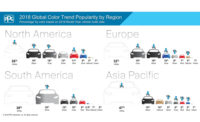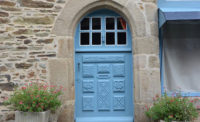PITTSBURGH – PPG recently unveiled its automotive color trends and data, citing blue as the fastest growing color for automobiles across the world.
In 2016, PPG data showed that blue increased by 3% as a preference for luxury, midsize and compact cars. This upward trend continued across a number of regions worldwide this year, with blue increasing as a color preference for luxury cars by 5%.
While blue may soon become more noticeable in the automotive marketplace, the applications on vehicle types around the world remain unique. In North America, blue is a popular choice for luxury cars while a top choice among mini cars in China. In Europe, consumers prefer blue on sports cars more frequently than any other car type.
Blue continued to dominate the North American International Auto Show the past four years, with featured applications on the Buick Avista concept car, Audi Sport, Volvo S90 and S60, as well as on various Mercedes, Porsche and Lexus models.
“PPG’s leading position in paint and color forecasting allows us to analyze cross-cultural and cross-industry trends with our 20 global color stylists from seven countries,” said Jane Harrington, PPG Manager, Automotive Color Styling. “While we know that automotive color trends are inspired by multiple industries, they are unique compared to fashion or home décor since the trends evolve and change slowly over time instead of significantly year-to-year. While white, black, gray and silver continue to be popular color choices, we’re seeing a steady increase in the desire for cars in varying blue and brown shades.”
PPG automotive color preferences by region for 2017 include:
- North America: White (25%) remained steady as the top color preference, while black (21%) and gray (17%) rose 2% and 5%, respectively. Silver (13%) dropped 6%, followed closely by red and blue (both 10%).
- South America: White (38%) continued to dominate in this region, while silver (31%) was close behind, rising 2% over prior year. Black (10%), gray (9%) and red (8%) remained other popular choices.
- Europe: White (32%), gray (18%), black (17%) and silver (9%) remained almost consistent with 2016, while blue (9%) saw an increase in consumer preference.
- Asia Pacific: White (44%) remained the most popular in this region. Black (15%) trailed, as well as silver (10%) and natural (10%), which includes gold, beige, orange and brown hues.
Comforting neutrals that consumers are craving in fashion, technology and their homes cause silver and gray to continue to be popular in automotive colors across all types of vehicles due to slight nuances in color and classic roots, Harrington noted. Chameleon-like hues that have gray and blue undertones remain top choices among consumers, as they represent calm, comfort and a middle ground.
PPG’s CORE Relation automotive color palettes for 2021 models include the following four color stories that connect and resonate with current consumer mindsets.
The Retreater theme focuses on the need to retreat from the pressures and overstimulation of technology and 24/7 schedules. It underscores living well, finding quiet time and creating opportunities for calm, balance and peace. The colors are earthen tones inspired by stone, marble, sand and clay paired with white and easy pastel shades. The trending gray, natural and blue-gray automotive color trends are perfectly depicted in this color story, shown through a global 1% decrease in the preference of red and a global 2% increase in the preference of gray.
Dream Weaver trend theme represents a rebellion to live loud, pursue pleasure and revel boldly in life. The eclectic palette expresses decadence and a carefree spirit, reflective of festival-goers and free-spirited consumers. Saturated bright colors are offset with high sparkle dark tones. Chromatic layered colors in tinted clears and varying degrees of saturation expand future automotive color options, including eye-catching reds, unusual greens and deep oranges.
The Commoner theme represents simplicity without disengaging from the world. Customers attracted to this palette focus on creating a minimalistic lifestyle with an appreciation of no-fuss basics. Key colors for this palette are a mix of almost-primary reds, blues, basic white, natural browns and greens.
The Brave theme represents transformation and strength, a visual reaction to global unrest and uncertainty. There is a secondary underlying quality of elegance and glamour, as this palette integrates opulent jewel tones, such as sapphire, elegant browns and warm neutrals.






